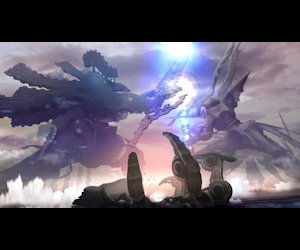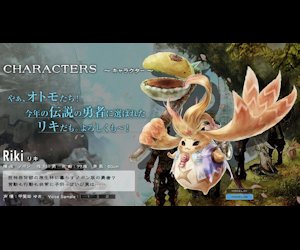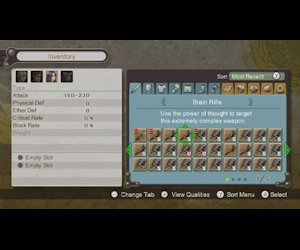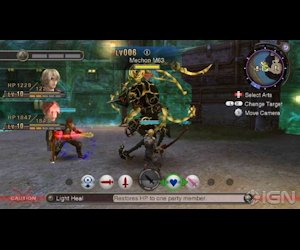Solo-Gamer Review: Xenoblade Chronicles
Here in North America, Japanese RPGs are waning in popularity, and one can be forgiven for believing that the glory days of the genre are well behind us. However, a curious thing happened when Game of the Year awards were being handed out for 2012: Xenoblade Chronicles, a JRPG for the Wii of all systems, kept popping up. Released in Japan almost three years ago as just Xenoblade, the game was localized after intense pressure from very vocal JRPG fanatics here in the U.S. (see Operation Rainfall). Sales in North America have been relatively good for a hardcore Wii title, with the game holding up well last April against the powerhouse Mass Effect 3, released one month earlier. Since then, it has been showered with positive reviews by gamers and critics alike, but can a JRPG, in this day and age, really be worth your time and effort, especially if it's a Wii exclusive?
STORY
 | | This is the entire game world, and if you don't think that's awesome, I hope I don't know you |
Xenoblade Chronicles takes place in a sparse universe made up of two titans fighting an apparently eternal battle on an endless sea. One titan, called the Bionis, is home to all organic life, while the other, called the Mechonis, is filled with machines. These machines, known as the Mechon, are engaged in a bloody campaign across the Bionis, exterminating whole colonies for reasons nobody can fathom. Facing the very real possibility of extinction, the only hope for the intelligent beings of the Bionis is the Monado, a mysterious blade capable of cutting through the Mechon with ease. However, the Monado is an unweildy weapon that only a small handful of people can hold, and even for those capable of carrying the blade, it winds up being their undoing.
Enter Shulk, a young mechanic who, when the Mechon invade his home of Colony 9, grabs the Monado and is granted incredible powers of foresight and swordsmanship. With an uncanny ability to weild the Monado and see glimpses of the future, Shulk becomes determined to avenge the lost colonies of the Bionis by taking the fight directly to the Mechon. Along the way, he builds a motley band of fighters, discovers that nothing in this world is as simple as it seems, and finds that vengeance may not be as important as survival.
This is a dense narrative filled with imaginative detail and an incredibly complex plot. It unfolds slowly at first, though, so that it never feels overwhelmingly confusing or convoluted, even in the end. There are at least a dozen major twists, many of which will catch you completely off guard, but none of them are undeserved or drive the story into the downright absurd nonsense into which many JRPGs devolve. If you make it to the end, even the most hard-to-fathom details are clear as day, though the surprisingly deep philosophical overtones will have you pondering what it all means long after you put down the controller, making this one of the most rewarding JRPG plots ever written.
 | | It wouldn't be Japanese without whatever the crap this is |
It's also driven by some pretty heavy-handed moral themes, made abundantly clear by the characters throughout, and some dialogue that is a little rough at times. I can forgive the overt sentimentality of a story that is all about finding your own future and learning to live in peace with everyone, as this is a fantasy that feels like it is written for slightly younger audiences. I can also forgive it because almost all of the characters are surprisingly well-written. Shulk is far from a perfect hero--he isn't very quick when it comes to understanding human relationships and he is driven by teenage rage rather than noble intentions--and many of his companions have unique reasons for joining the fight. There are a handful of JRPG stereotypes, of course, like the best friend who is a loveable brute and the goofy furry animal who thinks he's the greatest hero in the world, but the JRPG weirdness is fairly low-key and there is blessedly no underage sex object.
In fact, for reasons I cannot fully divulge without spoilers, this story feels like the ultimate JRPG fantasy. It has all the typical hallmarks--a young hero with a giant sword and an even bigger identity crisis, a world-wide war that is driven by the conflict between magic and machines, a substance that is responsible for all life, antagonists who have delusions of omnipotence, etc.--but it portrays them in the most accessible way I've ever seen. Though Xenoblade was never intended for North American audiences, it is nonetheless the greatest JRPG for them. It isn't dumbed down or easy, but it is constructed in a way that is more digestable than most other games of its type.
|
[Story: 10 - If you've ever liked a JRPG story, you'll probably love this one.]
|
|
GAMEPLAY
 | | You'd better be okay with micro-managing |
This is not an RPG for casual gamers. There are no waggle controls, the tutorial stage of the game is over in a heartbeat, and if you try to sprint through the game without taking the time to customize, explore, and level up, you will get slaughtered. There is a lot to keep track of and do, and even if you are some kind of JRPG savant, I don't see how you could possibly beat this game in fewer than 80 hours. (For the record, my first playthrough clocked in at about 120, and there were plenty of things I left unfinished.)
You can play with the Wii-mote and nunchuck, or you can play with the classic controller. I've heard the classic controller is the better way to go, but by the time I learned this, I had already gotten too used to the original set-up to change. You can bring up your map with the "1" button, your menu with the "-" button, and lock onto enemies (and treasure chests) with the "Z" trigger, using the "B" trigger to cancel. You move with the analog stick, navigate your menus with the control pad, and take charge of the camera with the "C" trigger. All but the camera is intuitive, taking no time at all to master, and relatively user-friendly. However, fumbling with the camera is frustrating and cumbersome, especially in mountainous areas. (Again, I've heard the classic set-up is a little bit better in that regard.)
 | | My advice during battles: don't blink |
Battles occur in real-time with visible enemies (no random battles, but it's impossible not to fight your way through the game), with your crew consisting of three characters (except for the occasional moment of one or two characters when the story calls for it, mostly in the beginning). You have a party leader whose actions you control through a simple "Arts" menu on the bottom of the screen, though he or she will auto-attack while you decide what to do. (You learn and level up your arts as you go.) The other members of your party are controlled by perfect A.I. that almost always does what you want it to, though every once in a while, you can stop time and dictate specific actions for everyone in something called a "chain attack" (semi-analogous to a limit break). You have to build "battle affinity" to perform certain actions, like reviving an incapacitated party member or activating a chain attack, which is done through certain special moves and the occasional quicktime button press. You also earn the ability very early on to catch the occasional glimpse of a future attack, which slows the action just long enough for you to contemplate a counter-measure. The battles move very quickly, requiring quick reflexes and keen strategizing, especially against the many difficult boss battles, and there is more going on than you can hope to follow in detail. It sounds overwhelming, but it really isn't.
Of course, it wouldn't be an RPG without the ability to customize your weapons and armor. This works like you expect, but one of the cool things here is that almost every piece of armor (and every weapon) has a unique look, which changes depending on which character is wearing it. This opens up a seemingly infinite series of possibilities, including the wonderful ability to put your big-breasted female characters in jungle bikinis (and the game physics have surprisingly vivid booby jiggle). Additionally, you can craft and add "gems" to your equipment, which predictably boost stats or offer special skills. The game is incredibly generous with its drops and shops, ensuring that money is never an issue. If you're really hard up for something specific, you can even trade with NPCs.
-e. magill 2/5/2013
|
|